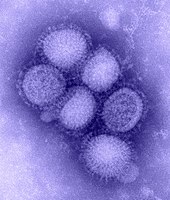
Photo from wikipedia
There is an urgent need to develop a broad-spectrum vaccine that can effectively prevent or eliminate the spread of co-circulating swine influenza virus strains in multiple lineages or subtypes. We… Click to show full abstract
There is an urgent need to develop a broad-spectrum vaccine that can effectively prevent or eliminate the spread of co-circulating swine influenza virus strains in multiple lineages or subtypes. We describe here that pre-exposure with a live virus generated via a A/WSN/1933(H1N1) reverse genetics system resulted in a significant reduction of viral shedding from pigs exposed to either a swine H1N1 virus or a swine H3N2 virus. At 3-day post challenge (DPC), approximately 1 log and 1.5 logs reductions of viral shedding were observed in the swine H1N1- and H3N2-challenged vaccinated pigs when compared to unvaccinated animals. A further decline in viral load was observed at 5 DPC where viral shedding was decreased by greater than 3 logs in vaccinated pigs receiving either the H1N1 or H3N2 virus challenge. Although the sera of the vaccinated pigs contained high titers of neutralizing antibodies against the vaccine strain, measured by Hemagglutination Inhibition (HI) assay, only suboptimal HI titers of neutralizing antibody were detected in the post-challenge serum of the vaccinated animals using the challenge swine H1N1 virus. The substantial genetic and antigenic differences between the vaccine virus and the challenge viruses imply that the observed protection may be mediated by mechanisms other than neutralization by IgG, such as non-neutralizing antibody activities, mucosal immunity, or conserved T cell immunity, which warrants further investigation.
Journal Title: Veterinary microbiology
Year Published: 2019
Link to full text (if available)
Share on Social Media: Sign Up to like & get
recommendations!